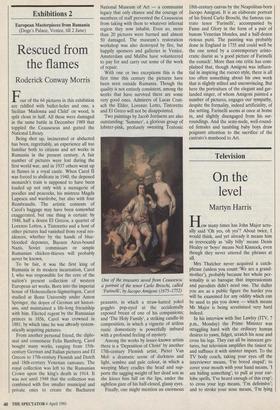Exhibitions 2
European Masterpieces from Rumania (Doge's Palace, Venice, till 2 June)
Rescued from the flames
Roderick Conway Morris
Four of the 64 pictures in this exhibition are riddled with bullet-holes and one, a Sicilian 'Madonna and Child' on wood, is split clean in half. All these were damaged in the same battle in December 1989 that toppled the Ceausescus and gutted the National Library.
Being shot up, incinerated or abducted has been, regrettably, an experience all too familiar both to citizens and art works in Rumania in the present century. A fair number of pictures were lost during the first world war, and in 1937 others went up in flames in a royal castle. When Carol II was forced to abdicate in 1940, the deposed monarch's train is supposed to have been loaded up not only with a menagerie of poodles and peacocks, his mistress Magda Lupescu and wardrobe, but also with four Rembrandts. The artistic contents of Carol's baggage may have been somewhat exaggerated, but one thing is certain: by 1948, half a dozen El Grecos, a quartet of Lorenzo Lottos, a Tintoretto and a host of other pictures had vanished from royal res- idences, whether by the hands of blue- blooded deposees, Buenos Aires-bound Nazis, Soviet commissars or simple Rumanian chicken-thieves will probably never be known.
To be fair, it was the first king of Rumania in its modern incarnation, Carol I, who was responsible for the core of the nation's present collection of western European art works. Born into the imperial house of Hohenzollern-Sigmaringen, Carol studied at Bonn University under Anton Springer, the doyen of German art histori- ans, and maintained a life-long friendship with him. Elected regent by the Rumanian princes in 1856, Carol was crowned in 1881, by which time he was already system- atically acquiring pictures.
From another personal friend, the diplo- mat and connoiseur Felix Bamberg, Carol bought many works, ranging from 15th- century German and Italian pictures and El Grecos to 17th-century Flemish and Dutch and 18th-century Venetian canvases. The royal collection was left to the Rumanian Crown upon the king's death in 1914. It was not until 1948 that the collection was combined with five smaller municipal and private ones to create the Bucharest National Museum of Art — a communist legacy that only chance and the courage of members of staff prevented the Ceausescus from taking with them to whatever infernal region they now inhabit. Even so, more than 20 pictures were burned and almost 50 damaged. The museum's restoration workshop was also destroyed by fire, but happily sponsors and galleries in Venice, Amsterdam and Malibu have volunteered to pay for and carry out some of the work of repair.
With one or two exceptions this is the first time this century the pictures have been seen outside Rumania. Though the quality is not entirely consistent, among the works that have survived there are some very good ones. Admirers of Lucas Cran- ach the Elder, Lorenzo Lotto, Tintoretto and El Greco will not be disappointed.
Two paintings by Jacob Jordaens are also outstanding: 'Summer', a glorious group of lobster-pink, profusely sweating Teutonic One of the treasures saved from Ceausescu: a portrait of the tenor Carlo Broschi, called Tarinelli, by Jacopo Amigoni (1675-1752) peasants, in which a straw-hatted yokel goggles pop-eyed at the accidentally exposed breast of one of his companions; and 'The Holy Family', a striking candle-lit composition, in which a vignette of artless rustic domesticity is powerfully imbued with a profound feeling of mystery. Among the works by lesser-known artists there is a 'Deposition of Christ' by another 17th-century Flemish artist, Pieter Van Mol: a dramatic scene of darkness and light, sombre and pale colour, in which a weeping Mary cradles the head and sup- ports the sagging weight of her dead son as she kisses him full on the lips, under the sightless gaze of his half-closed, glassy eyes.
Finally, one might mention an enormous 18th-century canvas by the Neapolitan-born Jacopo Amigoni. It is an elaborate portrait of his friend Carlo Broschi, the famous cas- trato tenor 'Farinelli', accompanied by Fame and Glory in the form of a pair of buxom Venetian blondes, and a half-dozen riotous putti. The painting was probably done in England in 1735 and could well be the one noted by a contemporary aristo- cratic diarist as 'a good picture of Farinelli the eunuch'. More than one critic has com- plained that, though Amigoni was influen- tial in inspiring the rococo style, there is all too often something about his own work that is slightly stilted and unconvincing. But here the portraiture of the elegant and gar- landed singer, of whom Amigoni painted a number of pictures, engages our sympathy, despite the formality, indeed artificiality, of the setting. Farinelli seems at once at home in, and slightly disengaged from his sur- roundings. And the semi-nude, well-round- ed females and tumbling baby boys draw poignant attention to the sacrifice of the castrato's manhood to Art.


















































 Previous page
Previous page